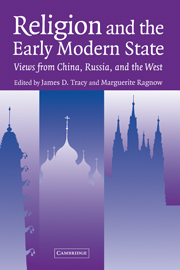Book contents
- Frontmatter
- Contents
- Contributors
- Acknowledgments
- Preface
- Religion and the Early Modern State
- Introduction
- PART I LIVED RELIGION AND OFFICIAL RELIGION
- PART II FORMS OF RELIGIOUS IDENTITY
- PART III THE SOCIAL ARTICULATION OF BELIEF
- AN EPILOGUE AT THE PARISH LEVEL
- Selected Annotated Bibliography of Secondary Works
- Index
Introduction
Published online by Cambridge University Press: 23 May 2010
- Frontmatter
- Contents
- Contributors
- Acknowledgments
- Preface
- Religion and the Early Modern State
- Introduction
- PART I LIVED RELIGION AND OFFICIAL RELIGION
- PART II FORMS OF RELIGIOUS IDENTITY
- PART III THE SOCIAL ARTICULATION OF BELIEF
- AN EPILOGUE AT THE PARISH LEVEL
- Selected Annotated Bibliography of Secondary Works
- Index
Summary
This book owes its origins to a desire to bring together two divergent approaches to the English Reformation. Early writers, most notably John Strype, viewed the Reformation primarily as an event in political history; they collected and analyzed the documents which established the independent Church of England. Writing in 1936, Sir Maurice Powicke went so far as to say that “the one definite thing which can be said about the Reformation in England is that it was an act of State.” The classic modern account of Reformation politics is that by A. G. Dickens, first published in 1964. This approach remained dominant through the 1970s. Several of Sir Geoffrey Elton's magisterial works described the religious policies of Henry VIII's chief minister Thomas Cromwell, while the statutes passed by Henry VIII's parliaments to regulate religion were studied by Stanford Lehmberg in his books The Reformation Parliament and The Later Parliaments of Henry VIII. Biographies of Thomas Cranmer naturally emphasized the primary role of the archbishop of Canterbury in enforcing reforms.
Works of this sort see the Reformation as coming rapidly and being imposed from the top down. But another sort of historiography, gaining popularity in the 1980s, viewed Reformation as a slow process working its way up from the bottom as Lutheran, Zwinglian, and Calvinistic views gradually gained acceptance by common people. Another perspective on popular belief emphasized the reluctance of many men and women to abandon their traditional Catholic beliefs.
- Type
- Chapter
- Information
- Religion and the Early Modern StateViews from China, Russia, and the West, pp. 1 - 10Publisher: Cambridge University PressPrint publication year: 2004



